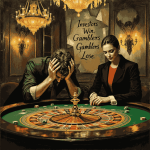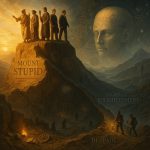
I Know That I Know Nothing About Investing, So Stop Crying and Start Now
Nov 3, 2024
Introduction:
In the labyrinthine world of finance, where fortunes are made and lost with the flicker of a ticker tape, there exists a paradoxical truth that eludes many: the path to true investment wisdom begins with the humble acknowledgement of one’s ignorance. This essay will explore the profound implications of embracing the Socratic paradox, “I know that I know nothing,” as a foundational principle for successful investing. By interweaving cutting-edge concepts from Mass psychology, technical analysis, and behavioural finance, we will uncover high-probability, unconventional strategies that can revolutionize your approach to the markets.
The Illusion of Knowledge: A Cognitive Trap
Let us examine the psychological underpinnings of our tendency to overestimate our knowledge and abilities. The Dunning-Kruger effect, a cognitive bias wherein individuals with limited expertise in a given domain overestimate their competence, is particularly pernicious in investing. This illusion of knowledge leads to a cascade of poor decisions, from overtrading to unwarranted risk-taking.
Consider the following scenario: An investor, encouraged by a streak of successful trades during a bull market, begins to believe they have “cracked the code” of stock picking. This misplaced confidence leads them to increase their position sizes and take on leveraged positions. When the market inevitably turns, their portfolio is decimated, leaving them bewildered and disillusioned.
To combat this cognitive trap, we must cultivate a mindset of “strategic ignorance.” This involves actively seeking out gaps in our knowledge and approaching the markets with a sense of wonder and curiosity rather than presumed expertise. Doing so opens us to new information and perspectives that can lead to more nuanced and effective investment strategies.
The Paradox of Expertise: When Knowledge Becomes a Liability
Counterintuitively, expertise can sometimes hinder the dynamic world of investing. The phenomenon known as “expert blindness” occurs when individuals with deep knowledge in a particular field become entrenched in established paradigms, making them less adaptable to changing circumstances.
To illustrate this point, let us examine the case of Long-Term Capital Management (LTCM), a hedge fund that boasted a team of financial luminaries, including Nobel laureates. Despite their unparalleled expertise, LTCM’s rigid adherence to complex mathematical models led to catastrophic losses when market conditions deviated from their assumptions. This is a stark reminder that even the most sophisticated knowledge can be rendered obsolete in market uncertainty.
To avoid falling into the trap of expert blindness, we must cultivate a mindset of perpetual learning and intellectual humility. This involves regularly challenging our assumptions, seeking out diverse perspectives, and remaining open to the possibility that our cherished beliefs may be wrong.
The Power of Negative Capability: Embracing Uncertainty
The Romantic poet John Keats coined the term “negative capability” to describe the capacity to embrace uncertainty and ambiguity without grasping for premature resolution. This concept has profound implications for investing, where the ability to navigate uncertainty is paramount.
By cultivating negative capability, investors can resist the urge to force patterns onto random market noise or to make hasty decisions based on incomplete information. Instead, they can maintain a state of open-minded receptivity, allowing them to capitalize on opportunities that others might overlook.
Probabilistic thinking is a practical application of negative capability in investing. Rather than seeking definitive answers, investors assign probabilities to various outcomes and adjust their strategies accordingly. This approach acknowledges the markets’ inherent uncertainty while providing a decision-making framework.
The Stoic Investor: Emotional Resilience in the Face of Market Volatility
The ancient Stoic philosophers espoused a philosophy of emotional resilience that remarkably applies to modern investing. By focusing on what is within our control and accepting what is not, we can cultivate a better-equipped mindset to weather the inevitable storms of market volatility.
One powerful technique derived from Stoic philosophy is negative visualization. Investors can inoculate themselves against the paralyzing effects of fear and panic when markets turn turbulent by regularly contemplating worst-case scenarios. This emotional preparation allows for clearer thinking and more rational decision-making during crises.
Moreover, by adopting a Stoic perspective, investors can reframe market downturns as opportunities for growth and learning rather than personal failures. This shift in mindset can lead to more consistent long-term performance by reducing the likelihood of emotional capitulation during market lows.
The Antifragile Portfolio: Thriving in Uncertainty
Nassim Nicholas Taleb’s concept of antifragility – the property of systems that gain from disorder – offers a revolutionary framework for portfolio construction. An antifragile investment approach seeks not merely to withstand market shocks but actually to benefit from them.
One unconventional strategy for building an antifragile portfolio is the “barbell approach.” This involves allocating a large portion of the portfolio (say, 80-90%) to highly safe assets, such as government bonds or cash, while investing the remaining portion in high-risk, high-reward opportunities. This strategy provides downside protection and the potential for outsized gains, allowing the portfolio to benefit from market volatility.
Another antifragile technique is using “positive asymmetry” in option strategies. Investors can create positions that thrive on uncertainty and market turbulence by focusing on options with limited downside and potentially unlimited upside. For example, buying out-of-the-money call options on undervalued stocks with strong fundamentals can provide significant upside potential with limited risk.
The Wisdom of Crowds: Harnessing Collective Intelligence
While individual expertise can be fallible, the aggregated wisdom of diverse groups often yields surprisingly accurate results. This phenomenon, known as the “wisdom of crowds,” can be leveraged to enhance investment decision-making.
One innovative application of this concept is using prediction markets for investment research. These markets allow participants to bet on the likelihood of various outcomes, such as company earnings or macroeconomic indicators. By aggregating many individuals’ diverse knowledge and perspectives, prediction markets can produce more accurate forecasts than traditional analyst estimates.
Investors can also tap into collective wisdom through social sentiment analysis. By analyzing patterns in social media discussions and online forums, sophisticated algorithms can gauge market sentiment and identify potential trading opportunities. However, it is crucial to approach this data critically, as social sentiment can also be subject to herding behaviour and manipulation.
The Quantum Investor: Embracing Superposition in Decision-Making
With its counterintuitive principles, Quantum mechanics offers a compelling metaphor for navigating the complexities of financial markets. Just as a quantum particle can exist in multiple states simultaneously until observed, savvy investors can maintain various, even contradictory, hypotheses about market conditions.
This “quantum approach” to investing involves developing bullish and bearish theses for each investment, assigning probabilities to various scenarios, and continuously updating these probabilities as new information becomes available. By maintaining this cognitive flexibility, investors can avoid becoming overly attached to any single narrative and remain adaptable to changing market conditions.
A practical implementation of this quantum mindset is scenario analysis in portfolio construction. By modelling multiple potential futures and their implications for various asset classes, investors can create robust portfolios prepared for numerous outcomes.
The Art of Inversion: Thinking Backwards for Forward Progress
The renowned investor and polymath Charlie Munger often emphasizes the power of inversion, which involves approaching problems backwards to gain new insights. In the context of investing, this technique can yield powerful results.
One application of inversion is to focus on avoiding catastrophic losses rather than solely pursuing gains. By systematically identifying and mitigating potential sources of permanent capital loss, investors can improve their long-term performance more effectively than by chasing elusive “home run” investments.
Another inversion technique is to study investment failures rather than successes. By analysing the common characteristics of failed investments and bankrupt companies, investors can develop a more nuanced understanding of risk factors and potential pitfalls.
The Fractal Nature of Markets: Self-Similarity Across Time Scales
Benoit Mandelbrot’s work on fractal geometry has profound implications for understanding market behaviour. The fractal nature of markets – their self-similarity across different time scales – challenges traditional assumptions about risk and return.
One practical application of fractal analysis is in technical analysis. By recognizing that chart patterns and market dynamics exhibit similar characteristics across different time frames, traders can gain insights into potential market movements and improve their timing of entries and exits.
Moreover, the fractal perspective underscores the importance of multi-time frame analysis. By examining market trends across various time horizons—from intraday to multi-year cycles—investors can develop a more comprehensive understanding of market dynamics and make more informed decisions.
The Memetic Investor: Navigating the Viral Nature of Financial Ideas
In the age of social media and instant communication, financial ideas and narratives can spread with unprecedented speed and impact. Understanding the memetic nature of market sentiment can provide a significant edge in navigating these viral phenomena.
One unconventional approach is actively monitoring and analysing emerging financial memes and narratives. Investors can potentially capitalise on subsequent market movements by identifying developing trends before they reach mainstream awareness. However, this strategy requires a delicate balance between being early enough to benefit from the trend and discerning enough to avoid falling prey to short-lived fads.
Another application of memetic thinking is brand analysis. By evaluating companies based on their “memetic potential”—their ability to generate and sustain viral marketing and customer loyalty—investors can identify businesses with strong, intangible competitive advantages.
Conclusion: The Paradoxical Path to Investment Wisdom
As we conclude this exploration of unconventional investment wisdom, we return to our central paradox: recognising ignorance as the foundation for actual knowledge. By embracing the Socratic ideal of intellectual humility, we open ourselves to a world of nuanced strategies and deeper understanding.
The journey from “crying” to “investing” is not merely about acquiring more information or developing complex models. It is about cultivating a mindset that thrives on uncertainty, remains adaptable to change, and continually seeks to challenge its assumptions.
By integrating insights from diverse fields—from quantum mechanics to memetics—we can develop a more holistic and resilient approach to investing. This interdisciplinary perspective allows us to see patterns and opportunities that others might miss while remaining grounded in the fundamental realities of market behaviour.
Ultimately, the most successful investors are not those who claim to have all the answers but those who ask the most insightful questions. By maintaining a stance of perpetual curiosity and embracing the mantra “I know that I know nothing,” we position ourselves to navigate the ever-changing landscape of financial markets with greater agility and wisdom.
As we face the uncertain future of global finance, let us remember that our greatest asset is not our knowledge but our capacity for learning and adaptation. In the grand game of investing, it is not the most confident or knowledgeable who ultimately triumph but those who remain humble, flexible, and ever-ready to embrace the profound mysteries of the market.














